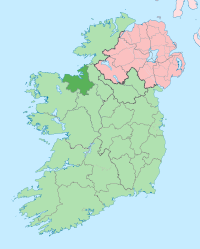County Sligo
| County Sligo Contae Shligigh |
||
 |
||
|---|---|---|
| Motto: Land of Heart's Desire | ||
| Location | ||
|
||
| Statistics | ||
| Province: | Connacht | |
| County seat: | Sligo | |
| Code: | SO | |
| Area: | 1,837 km2 (709 sq mi) (22nd) | |
| Population (2006) | 60,894 (26th) [1] | |
| Website: www.sligococo.ie | ||
County Sligo (Irish: Contae Shligigh) is one of the twenty-six counties of the Republic of Ireland and one of the thirty-two counties of Ireland. It is located in the province of Connacht. It was named after the town of Sligo (Irish: Sligeach) which is the anglization of the Irish Sligeach meaning Place of the Shells. The population of the county is 60,894 according to the 2006 census.[2] Sligo is the 22nd largest of Ireland's 32 counties in area and 25th largest in terms of population.[3] It is the fourth largest of Connacht's 5 counties in size and third largest in terms of population.
Contents |
Local government
Sligo County Council is the governing body for the county. It is divided into five Local Electoral Areas (LEAs) Ballymote, Dromore, Sligo-Drumcliffe, Sligo-Strandhill and Tubbercurry. There are 25 members elected to Sligo County Council.
Sligo is part of the Sligo-North Leitrim constituency and has three representatives (TD's) in Dáil Éireann, Eamon Scanlon, John Perry and Jimmy Devins. It also has two representatives to Seanad Éireann Marc MacSharry and Gearldine Feeney.
Culture
The megalithic cemetery of Carrowmore is located in County Sligo. It forms part of a huge complex of Stone Age remains connecting Carrowkeel in South Sligo to the Ox Mountains, to the Cuil Irra Peninsula, where Queen Maeve's tomb dominates the skyline from the crest of Knocknarea Mountain. The poet and Nobel laureate William Butler Yeats (1865–1939) spent much of his childhood in northern Sligo and the county's landscapes (particularly the Isle of Innisfree, in Lough Gill) were the inspiration for much of his poetry. Yeats said, "the place that has really influenced my life most is Sligo." He is buried in North County Sligo, "Under Ben Bulben", in Drumcliffe.
Music
County Sligo has a long history of traditional music. The south of the county is particularly noted with such musical luminaries as James Morrison, Michael Coleman, Paddy Killoran, Fred Finn , Peter Horan, Joe O'Dowd, Jim Donoghue, Martin Wynne, Oisín Mac Diarmada (of Téada), tin-whistle player Carmel Gunning and the band Dervish. The county has many traditional music festivals and one of the most well known is the Queen Maeve International Summer School, a traditional Irish Music summer school of music and dance which is held annually in August in Sligo Town. On the more contemporary music scene there are Westlife, Tabby Callaghan and The Conway Sisters who are from Sligo. Strandhill, about 9 km west of Sligo, hosts the Strandhill Guitar Festival [1] each year, featuring a wide variety of guitar music and musicians.
Towns and villages
- Achonry
- Aclare
- Ballaghnatrillick
- Ballinafad
- Ballintogher
- Ballymote
- Ballysadare
- Beltra
- Bunninadden
- Carney
- Castlebaldwin
- Cliffony
- Cloonacool
- Collooney
- Coolaney
- Dromore West
- Drumcliffe
- Easky
- Enniscrone
- Geevagh
- Grange
- Gurteen/Gorteen
- Kilglass
- Keash
- Monasteraden
- Mullaghmore
- Riverstown
- Rosses Point
- Skreen
- Strandhill
- Toorlestraun
- Tubbercurry
See also
| Historical populations | ||
|---|---|---|
| Year | Pop. | %± |
| 1659 | 6,877 | — |
| 1821 | 146,229 | 2026.3% |
| 1831 | 171,765 | 17.5% |
| 1841 | 180,886 | 5.3% |
| 1851 | 128,515 | −29.0% |
| 1861 | 124,845 | −2.9% |
| 1871 | 115,493 | −7.5% |
| 1881 | 111,578 | −3.4% |
| 1891 | 98,013 | −12.2% |
| 1901 | 84,083 | −14.2% |
| 1911 | 79,045 | −6.0% |
| 1926 | 71,388 | −9.7% |
| 1936 | 67,447 | −5.5% |
| 1946 | 62,375 | −7.5% |
| 1951 | 60,513 | −3.0% |
| 1956 | 56,850 | −6.1% |
| 1961 | 53,561 | −5.8% |
| 1966 | 51,263 | −4.3% |
| 1971 | 50,275 | −1.9% |
| 1979 | 54,610 | 8.6% |
| 1981 | 55,474 | 1.6% |
| 1986 | 56,046 | 1.0% |
| 1991 | 54,756 | −2.3% |
| 1996 | 55,821 | 1.9% |
| 2002 | 58,200 | 4.3% |
| 2006 | 60,894 | 4.6% |
| [4][5][6][7][8][9] | ||
- List of abbeys and priories in the Republic of Ireland (County Sligo)
- List of Sligo people
- Sligo GAA
- Sligo Rovers F.C.
References
- ↑ "Population of each Province, County and City, 2006". CSO Ireland, Principal Statistics. http://www.cso.ie/statistics/popofeachprovcountycity2006.htm. Retrieved 2007-05-31.
- ↑ Census 2006 - Population of each province, county and city
- ↑ Corry, Eoghan (2005). The GAA Book of Lists. Hodder Headline Ireland. pp. 186–191.
- ↑ For 1653 and 1659 figures from Civil Survey Census of those years, Paper of Mr Hardinge to Royal Irish Academy March 14, 1865.
- ↑ Census for post 1821 figures.
- ↑ http://www.histpop.org
- ↑ http://www.nisranew.nisra.gov.uk/census
- ↑ Lee, JJ (1981). "On the accuracy of the Pre-famine Irish censuses". In Goldstrom, J. M.; Clarkson, L. A.. Irish Population, Economy, and Society: Essays in Honour of the Late K. H. Connell. Oxford, England: Clarendon Press.
- ↑ Mokyr, Joel; O Grada, Cormac (November). "New Developments in Irish Population History, 1700-1850". The Economic History Review 37 (4): 473–488. doi:10.1111/j.1468-0289.1984.tb00344.x. http://www3.interscience.wiley.com/journal/120035880/abstract
External links
- Collection of Sligo Landscape Photographs
- Sligo County Council
- Sligo Borough Council
- Map of Sligo
- Sligoheritage.com
- Sligo Rovers F.C.
- County Sligo travel guide from Wikitravel
- History of Sligo, County and Town By William Gregory Wood-Martin
- Song, "Beautiful Sligo" sung by Michael McGloin,YouTube Video, with images.
|
||||||||||||||||||||

